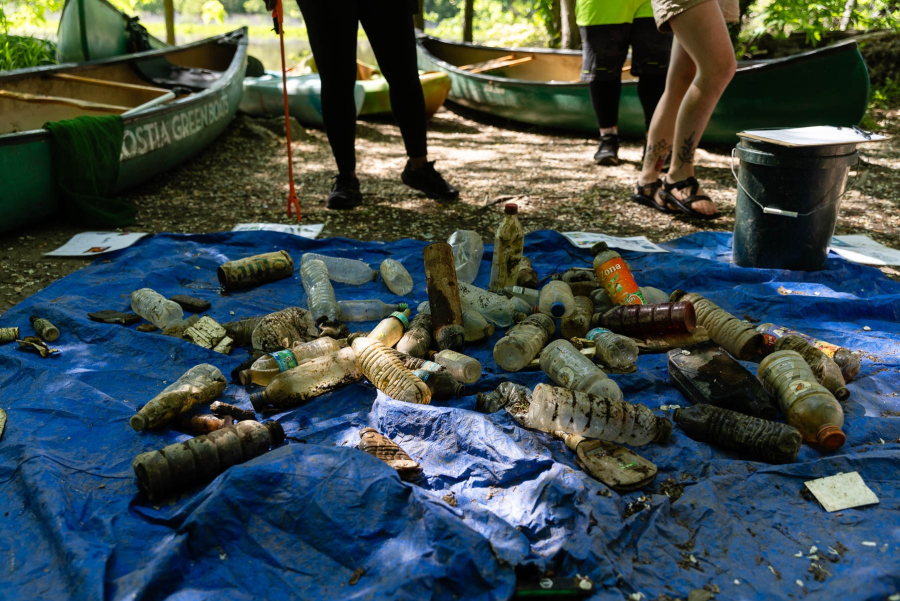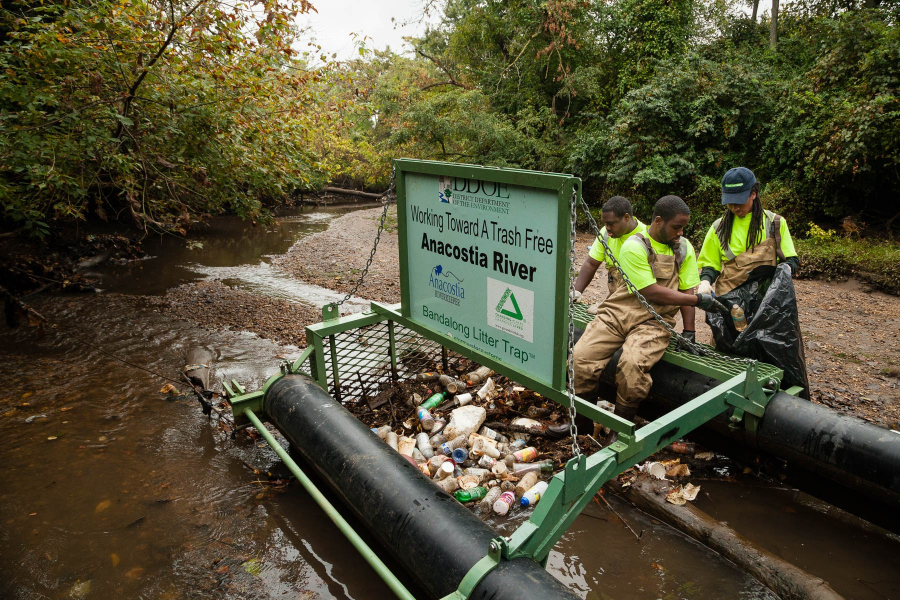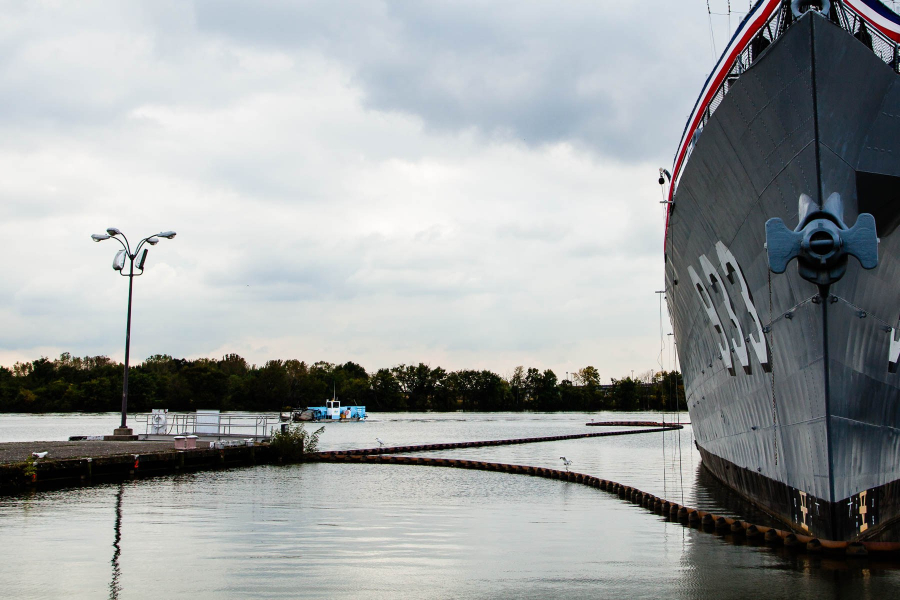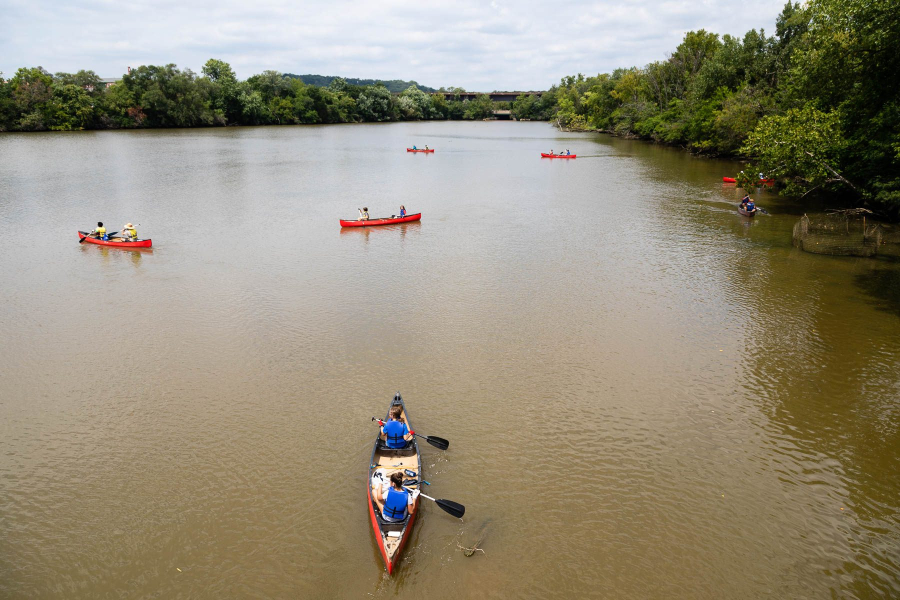Trash traps, clean teams, and other solutions for a trash-free Anacostia River
Find out how D.C. works towards the Anacostia River’s trash limit

Once known as “D.C.'s forgotten river,” the Anacostia River is gradually recovering from decades of pollution and disinvestment. An annual report card from the Anacostia Watershed Society shows that despite receiving a failing grade in 2023, the river’s water quality and ecosystem is slowly improving over the past 30 years. Freshwater mussels, wetland plants and river otters are a few of the species making a comeback.
But one issue that continues to plague the Anacostia is litter, especially plastics. Since 2011, the river has had a Total Maximum Daily Load (TMDL) for trash. Just like the Chesapeake Bay has a TMDL for the amount of nitrogen, phosphorus and sediment entering the estuary, the Anacostia’s Trash TMDL has a limit for the amount of man-made debris flowing into this historically polluted waterway.
Washington, D.C., along with Montgomery County and Prince George’s County in Maryland, work to meet the goals of the river’s Trash TMDL. We caught up with D.C. Department of Energy and the Environment (DOEE) to learn more about what the nation’s capital is doing to reduce litter in the Anacostia, and what partners are helping in this effort.

Trash traps and sea bins
One of D.C.’s most effective tactics for reducing litter are the eight trash traps installed along the river. With funding from DOEE, the Anacostia Riverkeeper and several other nonprofits maintain and clean out these traps, which capture several thousands pounds of trash each year.
“We look for opportunities where there are outfalls that we know are particularly problematic in discharging out a lot of trash, and then work with grantee organizations to maintain and clean those trash traps out on a regular basis,” said Jonathan Champion, associate director of the Water Quality Division at the D.C. DOEE.
Anacostia Riverkeeper also manages a handful of “seabins” that suck water into a basket to capture the trash. These innovative tools are designed specially for marinas, which tend to accumulate litter flowing down the river.
Skimmer boats
Since 2017, the water utility DC Water has been operating two skimmer boats—named Flotsam and Jetsam—that travel along the Anacostia and Potomac river picking up debris. According to the company’s website, these two boats remove over 400 tons of floating debris and trash each year!
DC Water was one of the first utilities in the United States to utilize skimmer boats back in 1992. Today’s modern boats are each 50 feet long, 13 feet wide and weigh 26,000 pounds.
“Part of our work minimizing pollution includes using our skimmer boats every day to retrieve trash that has washed into the waterway,” said previous CEO and general manager of DC Water, George S. Hawkins, in a 2017 press release.

Clean Teams and street sweepers
To try and keep litter from reaching the water in the first place, D.C. relies on 40 different Clean Teams to patrol areas where trash typically collects. D.C.’s Department of Small and Local Business Development (SLBD) provides grants to nonprofits and businesses to manage these clean teams.
According to Virginia-Marie Roure, a manager for SLBD, members of the clean teams are oftentimes individuals who have faced barriers to employment, whether because they have been justice-involved or have had difficulty accessing stable housing. The teams are out picking up litter rain, snow and shine and remove millions of pounds of trash and recycling annually.
“They keep our commercial areas attractive, empty trash cans that are full and sweep up litter,” Roure said.
In addition to Clean Teams, the Department of Public Works sends out street sweepers to litter hotspots from March 1st to October 31st. Residents and businesses can apply for a street sweeper to come out.
Volunteer trash cleanups
For decades, Anacostia Riverkeeper has been organizing volunteer trash cleanups through their Clean Waterways program. According to the organization’s website, over 160 cleanup events have been held since 2014 (about 15 a year), removing roughly 153,800 pounds of trash.
Anacostia Watershed Society and Ward 8 Woods Conservancy also host clean up events that benefit the Anacostia. The Alice Ferguson Foundation hosts similar trash cleanups, though on the Potomac River, the other major waterways in D.C.

Bills and regulations
While trash traps, skimmer boats and clean up crews help remove litter from the environment, social change is needed to reduce the amount of plastic and litter that our society generates.
In Washington, D.C., consumers pay a 5 cent fee for using single-use carryout plastic bags at certain retail and food-serving businesses. Funds from this fee go toward
projects that support a clean and healthy Anacostia watershed, such as the Anacostia River Explorers Boat Tour program. Since being implemented in 2009, the law has resulted in far fewer plastic bags ending up in the Anacostia River, with 80% of residents saying that they use fewer bags.
D.C. has also banned businesses and organizations from using disposable food service ware made of Styrofoam as well as single-use plastic straws. Food serving businesses are also required to use take-out material that is either recyclable or compostable.
What’s on the horizon?
Despite all the efforts being carried out in D.C., litter still makes its way into the Anacostia River on a daily basis. Plastics are of the biggest concern, because they break down into microplastics that are consumed by humans and wildlife.
According to DOEE, the Anacostia Watershed Trash TMDL is in the process of being rewritten after it was challenged in court by stakeholders claiming the standards for trash reduction were not being met.
Trey Sherard of Anacostia Riverkeeper says that plastic bottles make up roughly 60% of the trash that the organization's trash traps remove from the river. Sherard believes a ban on plastic bottles should be implemented to rescue the river from plastic pollution, though no city or state in the U.S. has been able to devise such a law.
“That’s a really challenging policy to craft and put in place,” said Matt Gallagher, Branch Chief in DOEE’s Water Quality Division.
If you would like to help keep litter out of your local waterway, use our Find a Bay Organization map to find an environmental group near you and see if they host trash clean ups. To use less plastics, follow these tips from the Environmental Protection Agency.

Comments
Hi Jake,
Great article! I'd like to point out that Anacostia Watershed Society diligently collects trash data from the traps and it is this data that helped pass DC's plastic bag bill and styrofoam ban. It is an important and under appreciated effort that I feel is important for the readers to know.
Thank you.
Thank you!
Your comment has been received. Before it can be published, the comment will be reviewed by our team to ensure it adheres with our rules of engagement.
Back to recent stories